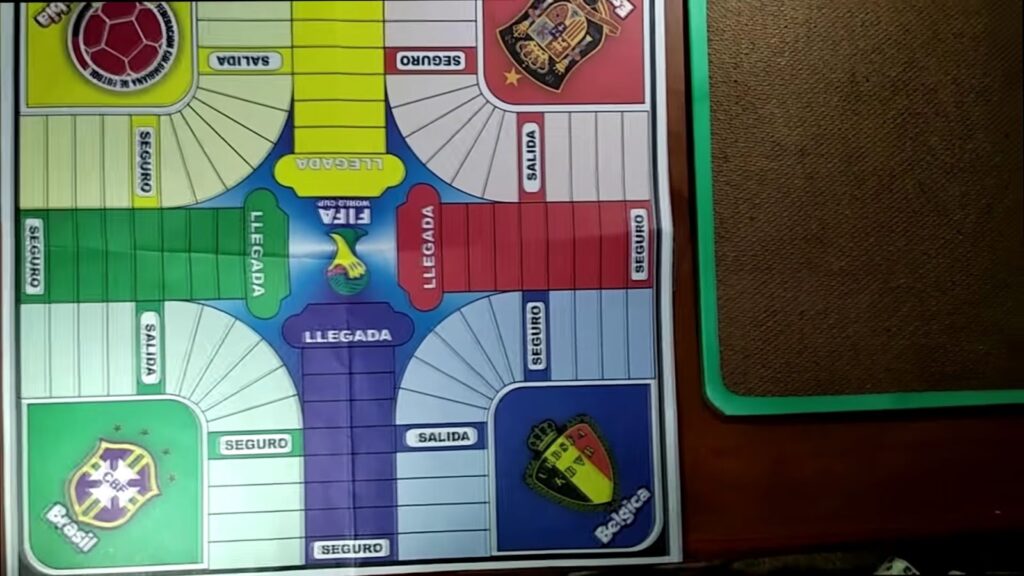The game of Parqués stands as a timeless icon within Colombian cultural heritage, nestled alongside the country’s renowned beverages and sporting activities. Have you ever wondered about its origins? Or perhaps, are you familiar with its intricate rules and gameplay? Delve into the following narrative to unearth captivating insights that are bound to captivate your imagination.
Decoding Parqués: Colombia’s Classic Board Game
Acknowledged as a cultural phenomenon and beloved just as much as the iconic vallenato music in Colombia, Parqués has found a place in the hearts of families throughout the country. The popularity of this board game has grown to such an extent that it has led to the organization of dedicated tournaments and the creation of a 3D version for tech-savvy gaming enthusiasts.
The game may initially seem like a journey of luck, dictated by the roll of the dice. But for seasoned players, Parqués is a thought-provoking game of strategy and intellect. Winning requires more than just good fortune; it hinges on a keen understanding of the game mechanics and the ability to outwit opponents through strategic maneuvers.
At its core, Parqués is a race to the finish line. The objective? Move your pieces across the board faster than your adversaries. But the journey is laden with hurdles and requires shrewd navigation. Here’s what makes this game both challenging and appealing:
- The Objective: Each player’s primary goal is to move all their pieces from the starting point to the home base before the other players. Straightforward on the surface, but the complexity comes into play when considering the obstacles on the way;
- Strategic Gameplay: Luck definitely plays a role in Parqués, as the roll of the dice can be unpredictable. However, the choices made after each roll, the tactical maneuvers, and the ability to anticipate opponent moves, constitute the heart of the game’s strategical aspects;
- Overcoming Obstacles: Throughout the game, obstacles emerge that can hinder the progress of the players. Knowing how to navigate these challenges is the ultimate test of a player’s strategic prowess.
Mastering Parqués might seem daunting initially, but with understanding and practice, any player can become proficient and thoroughly enjoy this intriguing game.
A Glimpse into the Rich History of Parqués
Parqués, while a national treasure of Colombia, shares its roots and similarities with games from across the world. Interestingly, it is believed that the earliest form of this game heralded from India and was known as Chaupar. Historical accounts attribute the game’s original patronage to the Sultan of Brunei, Emperor Abdul Momin, who was said to have been an avid player.
As history unfolded, echoes of this game traveled around the globe, carried along intricate routes of human migration and trade. Slavery, an unfortunate chapter in human history, became a vehicle for the diffusion of Chaupar. Slaves from regions like India, China, and other Asian territories brought over to work in South American sugar mills brought along bits of their culture, including this compelling game.
Yet, as the game spread, it morphed, adapting to local cultures and customs. Thus, many variations emerged, including Parcheesi, Parchís, and Ludo, each with their own unique twists while retaining the underlying essence of the original game. These variations mainly differ in aspects such as:
- Number of Dice: Some versions use one, while others use two dice;
- Pieces Utilized: The number and type of game pieces can differ significantly;
- Board Size: The grid layout and size of the game boards vary;
- Game Rules: The most diversified feature is the game rules, which are often unique to each version.
Colombian Parqués, though, has carved out its unique identity among these versions, uniting families across the country in bouts of strategy-filled fun and friendly competition. Despite its rich, intercontinental history, at its heart, Parqués remains a beloved Colombian tradition that continues to captivate its players, young and old alike.
The Mechanics Behind Parqués: A Step-by-Step Guide
Parqués is an engaging game that prides itself on its simplicity, flexibility, and unexpected twists. The game can accommodate between 2 to 12 players, depending on the version of the board being used. Before diving into the thrill of the game, it’s vital for players to familiarize themselves with the various components of the Parqués board:
Key Elements of the Parqués Game Board
- The Jail: This serves as the starting block for all players. Before a player can participate, they must first free at least one of their pieces from jail. Achieving this depends on a calculated roll of the dice;
- The Home Box: This is the first stop for pieces once they have been liberated from the jail. It’s from here that they commence their journey around the board;
- The Safe Box: Always a welcomed sight for any player, landing a piece here grants it immunity from capture by any opponents;
- The Arrival Box: This is the final destination. Successfully maneuvering a piece here after circumnavigating the board gets you one step closer to victory.
Starting the Game:
Every player starts off with four pieces, all of identical color, which are placed in the jail. The race then begins to free these pieces. Players take turns rolling the dice three times, hoping to roll doubles which allow them to release their pieces from jail.
Navigating the Board:
With pieces freed and placed in the home box, the real game begins. Each player rolls the dice once per turn, using the combined number rolled to advance one or more pieces around the board. For instance, if a player rolls a 1 and 4, they can choose to move a single piece 5 spaces, or two pieces 1 and 4 spaces respectively. This is where the game’s strategic component comes into play.
In Parqués, each roll of the dice and each move on the board carries with it a decision. Whether to advance a single piece quickly or move multiple pieces simultaneously, when to aim for safety, and when to risk it all for a swift victory. Each choice has potential consequences and could either bring you closer to being the reigning Parqués champion or send you back to square one.
Ultimately, the aim of Parqués is to reach the arrival box with all your pieces before your opponents, but achieving this requires tact, strategy, and a little bit of luck. Understanding the rules is just the first step; mastering the game takes practice, patience, and clever thinking. So grab a Parqués board, gather some friends, and let the strategic battles begin!
Mastering the Art of Capturing in Parqués
Capturing opponents’ pieces is a thrilling aspect of Parqués, adding a layer of dilemmas and strategy to the game. As you progress around the board, landing on a square occupied by an opponent allows you to “capture” their piece, sending it straight back to jail. This can dramatically shift the game’s dynamics and possibly put you in a leading position.

Remember, the same can happen to you, making your journey around the board an exciting blend of careful planning and strategic maneuvering. To protect your pieces from being captured, aim to land them in the safe box. However, capturing is more than a mere chance occurrence – it’s compulsory. If you overlook a chance to capture an opponent’s piece, you receive a penalty, and your piece ends up in jail. The surveillance is communal, and any player can call out a missed capture, termed as “soplar.”
The game takes a unique twist when your pieces are on the home box, granting them immunity from being captured. While playing Parqués, each player gets only one chance per turn to roll the dice, but there are a few exceptions to this rule:
- Jailbreak Roll: When your pieces are in jail, you get three chances to roll a pair and set them free;
- Pair Bonus: Rolling a pair during your turn grants you an additional roll, thus increasing your chances to advance;
- Triple Pair Boost: If luck favors you and you roll three pairs consecutively, you’re granted the privilege to advance one piece directly to the final box.
Conversely, the end game of Parqués brings about its own set of challenges. Once your pieces have made the complete circuit of the board and reached the nine-space finish box, your strategy needs to evolve. At this stage, you have to roll the exact number corresponding to the spaces left to reach the end. You are limited to one die, raising the stakes and tension as you near victory. The precision required at this stage exemplifies the fusion of luck and tactics that Parqués embodies. The player who navigates these challenges most effectively and gets all their pieces to the end first is crowned the winner.
Unveiling the strategies of Parqués: Game Tips and Tricks
At first glance, Parqués may seem like a simple race around a board ruled by the luck of the dice. In reality, it’s a thought-provoking strategy game where your decisions can significantly impact your success. To excel in Parqués, consider these strategic insights:
- Stay Vigilant: Be aware of your pieces’ positions, the proximity to opponents’ pieces, and the distance to safe boxes. Proactively monitor the board situation and plan your moves accordingly;
- Watch Your Opponents: Apart from focusing on your game, keep an eye on your opponents’ moves. This not only helps in planning your actions but also allows you to spot any missed captures on their part. Being the first to call out a missed capture, popularly known as “soplar,” sends their piece to jail, benefitting your game;
- Strategic Liberations: Consider the best times to liberate your pieces from jail. Sometimes, it’s advantageous to keep pieces safe in jail until the board is less crowded or threats have been eliminated;
- Balance Risk & Safety: The thrill of capturing an opponent’s piece should be weighed against the potential risk of being captured yourself. Striking a balance between aggressive and defensive play is key to success;
- Use Dice Wisely: When you roll a number that can be split across pieces, think carefully. Moving multiple pieces could simultaneously advance your game and protect against captures. On the other hand, moving a single piece might be quicker and more conducive for that piece’s safety.
Parqués is more than just an entertaining game; it is an engaging fusion of strategy, chance, and board awareness that can quickly turn into an intense, competitive challenge. Despite the competition, always remember to enjoy the game and the company. After all, a well-played game of Parqués is as much about the fun and camaraderie as it is about the ultimate victory. So gather your friends, set up the board, and let the strategic showdown begin!
Conclusion
In conclusion, Parqués is not just a game but a cherished symbol of Colombian culture, intertwined with its beverages and sports. Exploring its origins and rules unveils a rich tapestry of tradition and history that continues to fascinate and engage players across generations.





